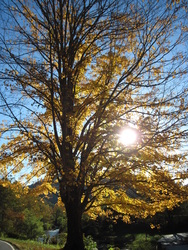 In times of stress and uncertainty, as we rush from one indoor location to another, it can be easy to become “ungrounded”—to lose that deeper connection to ourselves and that which supports and nourishes us. When we are ungrounded we tend to feel anxious, depressed or uneasy. Often, it is hard to put a finger on what is “wrong”. There are many ways to ground and center ourselves at such times. Taking a deep, slow breath and scanning our bodies is a start. Beginning at the top of your head, be aware of the physical sensations present, then slowly guide your awareness down through your body…your face, neck, shoulders, arms, chest and back, hips, legs and feet—simply pay attention as you scan. And breathe. What do you become aware of? This isn’t about changing anything, it’s about connecting with yourself. When you reach your toes, take an extra moment to bend your knees slightly and, with a slow, deliberate breath, gentle bounce up and down for 20 or 30 seconds. Allow the bounce to be soft and rather subtly. Imagine that any anxiety or unwanted sensations are being knocked loose from within you and falling to your feet where they are expelled into the ground. Another manner of grounding connects you, not only internally, but externally but assisting you in re-linking with the land that ultimately supports you. When climate permits, take off your shoes and socks and head out-of-doors. Walk on the bare earth…feel the grass under your feet, or mud squish between your toes. Breathe. Really allow yourself to experience the sensation of being connected to the earth. Imagine your stress, your worries and cares are draining down through your body and pouring out the soles of your feet into the ground and descending downward even further, where they are released and composted into something else. A third method of grounding that can be utilized during times when the climate (or your comfort level) won’t allow you to walk about barefoot, is to approach a tree. Approach with awareness and respect. Breathe (see a theme here?). Pay attention to your physical experience as you come closer to the tree. Again, there is no need to change anything, simply be aware. Reach out and place your hands on or around the tree trunk (that’s right, I’m encouraging you to hug a tree). Pay attention to the feel of the bark under your hands and the sense of contact between yourself and the tree. Then give your attention to what cannot be seen. Visualize the inner world of the tree, the delightful way in which it is rooted into the landscape and the marvelous and efficient manner in which it’s deep roots draw sustenance from the earth. Lean forward against the tree and once more breathe deeply. Imagine your feet sprout roots that dig down into the deep layers of the earth as well. As you breathe, imagine the power of the land is being drawn upward into the soles of feet and then fills your whole body with relaxed power. Allow this visualization to continue for as long as feels appropriate, then allow the image to fade. See the roots from your feet draw up into you once more. With a final breathe, give thanks and go back about your day. These three exercises can be done individually or together as your time and desire allows. However you have engaged with them, be sure to pay attention as you go back about your day? Has you experience of anxiety or unease shifted? Let me know!
0 Comments
When Tree Die, People Die by LIndsay Abrams, The Atlantic
The blight was first detected in June 2002, when the trees in Canton, Michigan, got sick. The culprit, the emerald ash borer, had arrived from overseas, and it rapidly spread -- a literal bug -- across state and national lines to Ohio, Minnesota, Ontario. It popped up in more distant, seemingly random locations as infested trees were unwittingly shipped beyond the Midwest. Within four years of first becoming infested, the ash trees die -- over 100 million since the plague began. In some cases, their death has an immediate impact, as they fall on cars, houses, and people. In the long term, their disappearance means parks and neighborhoods, once tree-lined, are now bare. Something else, less readily apparent, may have happened as well. When the U.S. Forest Service looked at mortality rates in counties affected by the emerald ash borer, they found increased mortality rates. Specifically, more people were dying of cardiovascular and lower respiratory tract illness -- the first and third most common causes of death in the U.S. As the infestation took over in each of these places, the connection to poor health strengthened. To read full article, click here. |
AuthorBryan Dieterich, MA, LPC Archives
March 2020
Categories
All
|
 RSS Feed
RSS Feed
